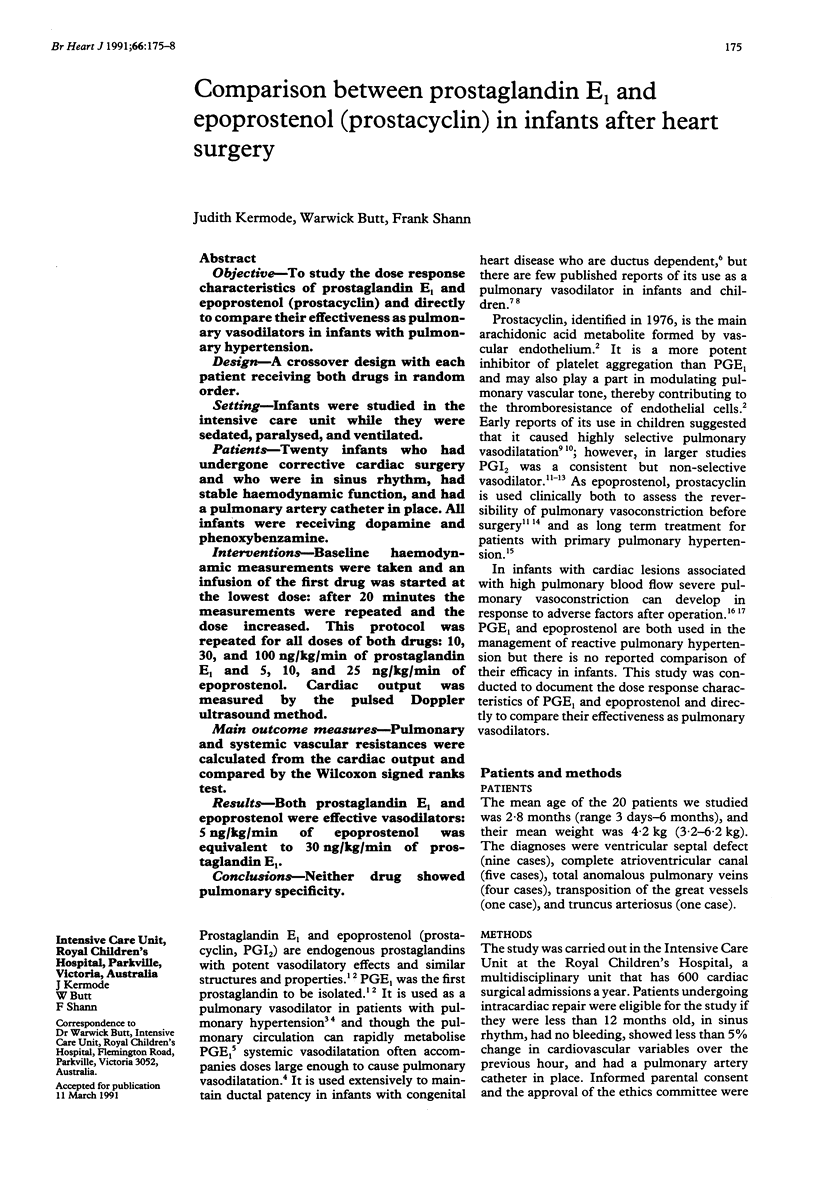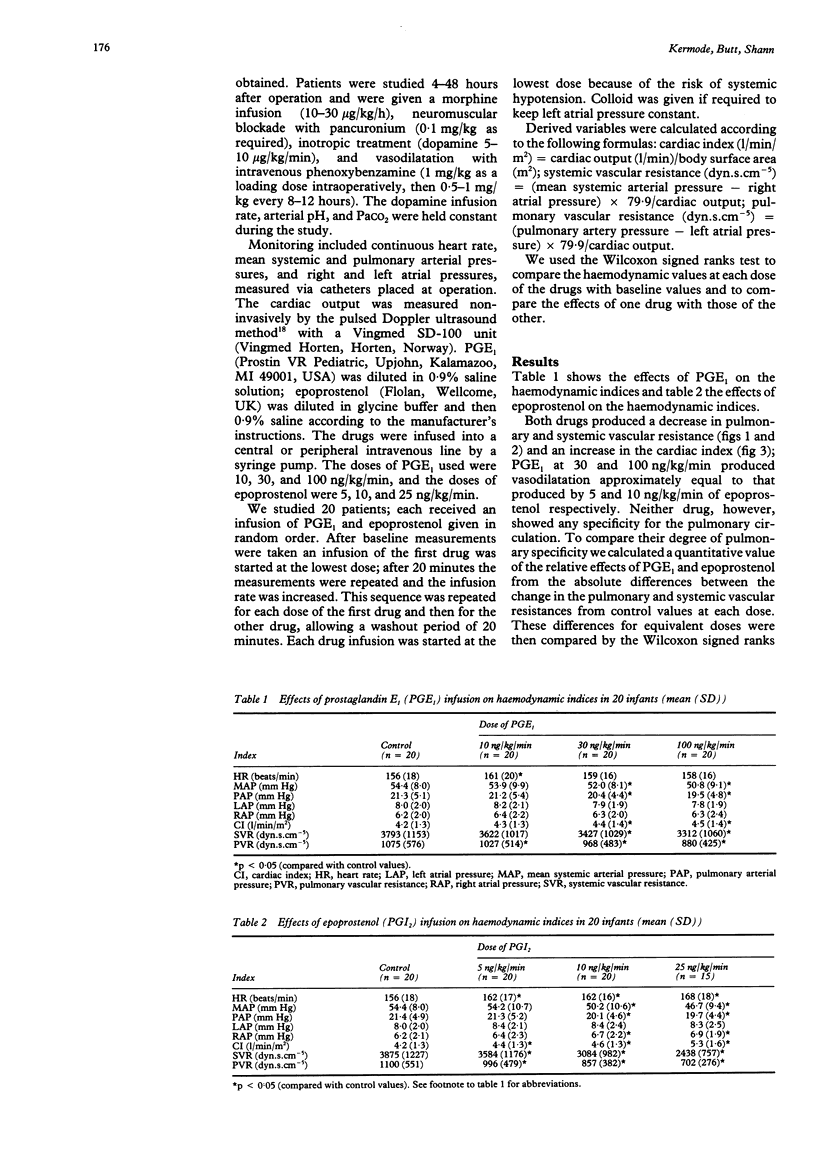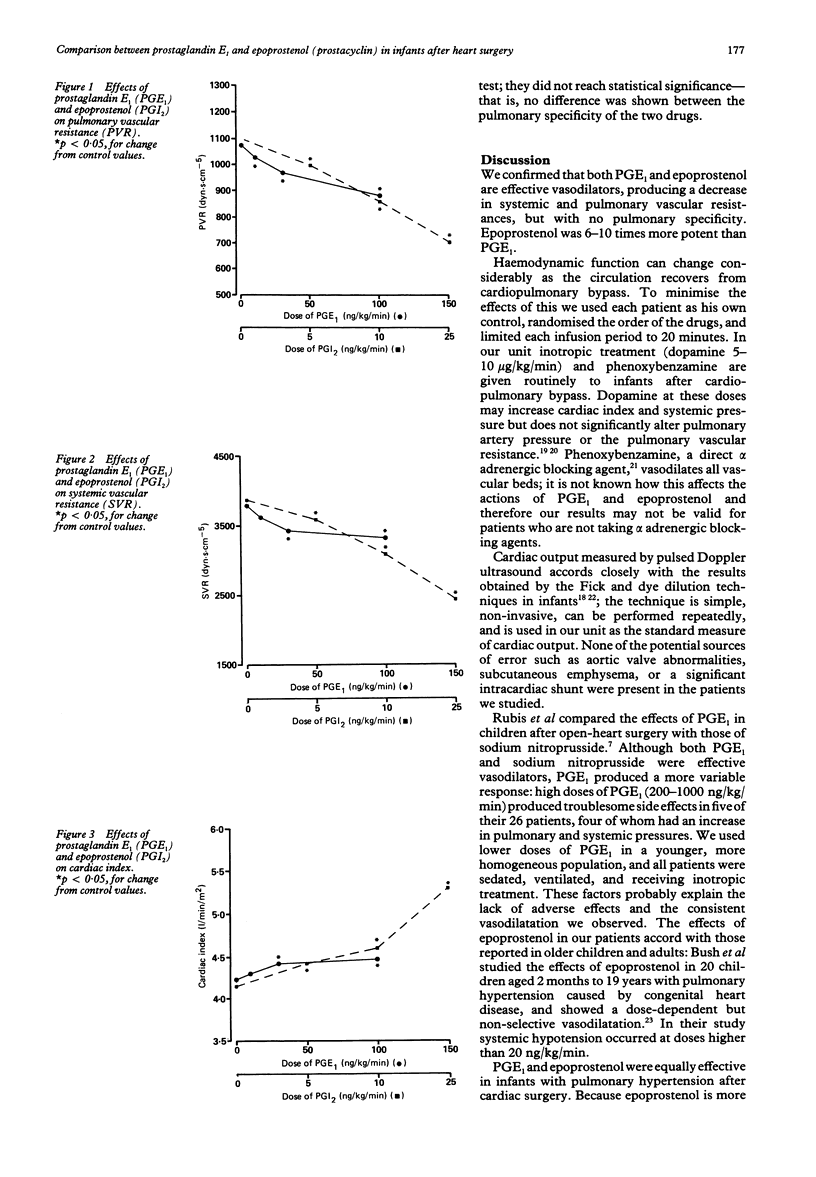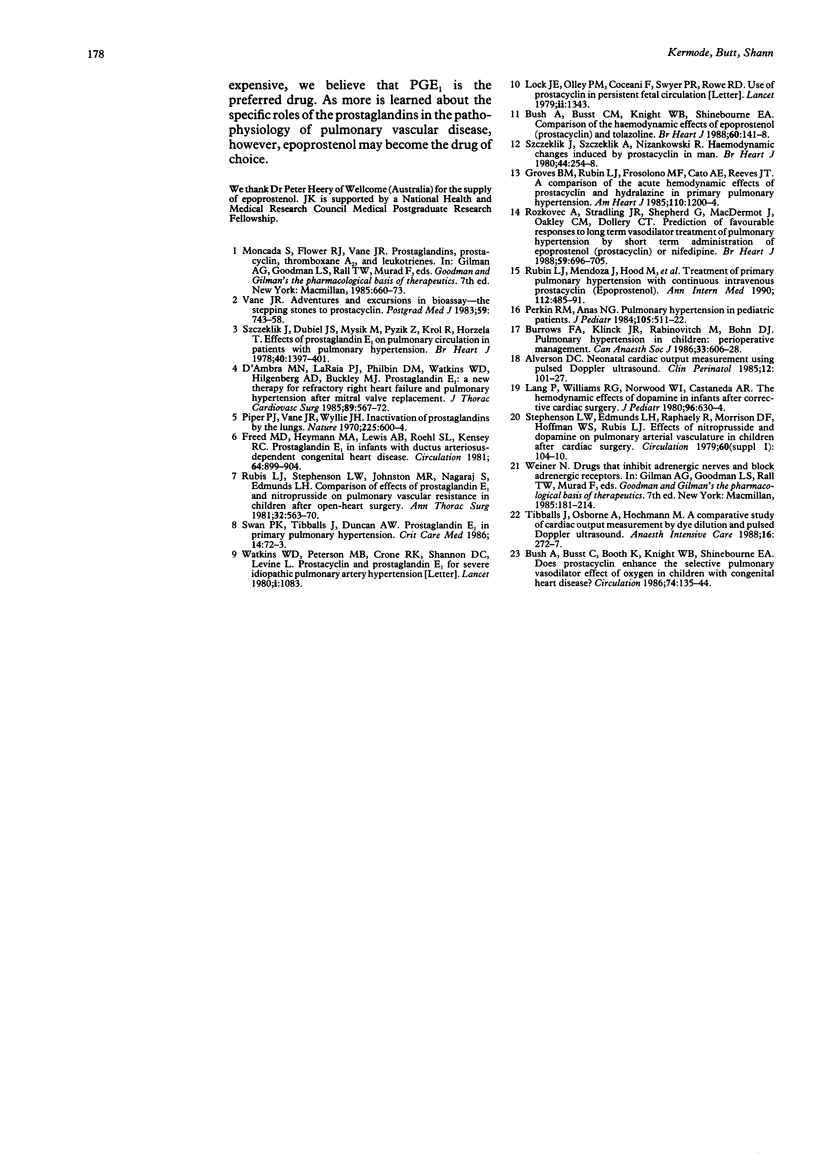Abstract
OBJECTIVE--To study the dose response characteristics of prostaglandin E1 and epoprostenol (prostacyclin) and directly to compare their effectiveness as pulmonary vasodilators in infants with pulmonary hypertension. DESIGN--A crossover design with each patient receiving both drugs in random order. SETTING--Infants were studied in the intensive care unit while they were sedated, paralysed, and ventilated. PATIENTS--Twenty infants who had undergone corrective cardiac surgery and who were in sinus rhythm, had stable haemodynamic function, and had a pulmonary artery catheter in place. All infants were receiving dopamine and phenoxybenzamine. INTERVENTIONS--Baseline haemodynamic measurements were taken and an infusion of the first drug was started at the lowest dose: after 20 minutes the measurements were repeated and the dose increased. This protocol was repeated for all doses of both drugs: 10, 30, and 100 ng/kg/min of prostaglandin E1 and 5, 10, and 25 ng/kg/min of epoprostenol. Cardiac output was measured by the pulsed Doppler ultrasound method. MAIN OUTCOME MEASURES--Pulmonary and systemic vascular resistances were calculated from the cardiac output and compared by the Wilcoxon signed ranks test. RESULTS--Both prostaglandin E1 and epoprostenol were effective vasodilators: 5 ng/kg/min of epoprostenol was equivalent to 30 ng/kg/min of prostaglandin E1. CONCLUSIONS--Neither drug showed pulmonary specificity.
Full text
PDF



Selected References
These references are in PubMed. This may not be the complete list of references from this article.
- Alverson D. C. Neonatal cardiac output measurement using pulsed Doppler ultrasound. Clin Perinatol. 1985 Feb;12(1):101–127. [PubMed] [Google Scholar]
- Burrows F. A., Klinck J. R., Rabinovitch M., Bohn D. J. Pulmonary hypertension in children: perioperative management. Can Anaesth Soc J. 1986 Sep;33(5):606–628. doi: 10.1007/BF03014268. [DOI] [PubMed] [Google Scholar]
- Bush A., Busst C. M., Knight W. B., Shinebourne E. A. Comparison of the haemodynamic effects of epoprostenol (prostacyclin) and tolazoline. Br Heart J. 1988 Aug;60(2):141–148. doi: 10.1136/hrt.60.2.141. [DOI] [PMC free article] [PubMed] [Google Scholar]
- Bush A., Busst C., Booth K., Knight W. B., Shinebourne E. A. Does prostacyclin enhance the selective pulmonary vasodilator effect of oxygen in children with congenital heart disease? Circulation. 1986 Jul;74(1):135–144. doi: 10.1161/01.cir.74.1.135. [DOI] [PubMed] [Google Scholar]
- D'Ambra M. N., LaRaia P. J., Philbin D. M., Watkins W. D., Hilgenberg A. D., Buckley M. J. Prostaglandin E1. A new therapy for refractory right heart failure and pulmonary hypertension after mitral valve replacement. J Thorac Cardiovasc Surg. 1985 Apr;89(4):567–572. [PubMed] [Google Scholar]
- Freed M. D., Heymann M. A., Lewis A. B., Roehl S. L., Kensey R. C. Prostaglandin E1 infants with ductus arteriosus-dependent congenital heart disease. Circulation. 1981 Nov;64(5):899–905. doi: 10.1161/01.cir.64.5.899. [DOI] [PubMed] [Google Scholar]
- Groves B. M., Rubin L. J., Frosolono M. F., Cato A. E., Reeves J. T. A comparison of the acute hemodynamic effects of prostacyclin and hydralazine in primary pulmonary hypertension. Am Heart J. 1985 Dec;110(6):1200–1204. doi: 10.1016/0002-8703(85)90013-4. [DOI] [PubMed] [Google Scholar]
- Lang P., Williams R. G., Norwood W. I., Castaneda A. R. The hemodynamic effects of dopamine in infants after corrective cardiac surgery. J Pediatr. 1980 Apr;96(4):630–634. doi: 10.1016/s0022-3476(80)80727-x. [DOI] [PubMed] [Google Scholar]
- Lock J. E., Olley P. M., Coceani F., Swyer P. R., Rowe R. D. Use of prostacyclin in persistent fetal circulation. Lancet. 1979 Jun 23;1(8130):1343–1343. doi: 10.1016/s0140-6736(79)91970-6. [DOI] [PubMed] [Google Scholar]
- Perkin R. M., Anas N. G. Pulmonary hypertension in pediatric patients. J Pediatr. 1984 Oct;105(4):511–522. doi: 10.1016/s0022-3476(84)80413-8. [DOI] [PubMed] [Google Scholar]
- Piper P. J., Vane J. R., Wyllie J. H. Inactivation of prostaglandins by the lungs. Nature. 1970 Feb 14;225(5233):600–604. doi: 10.1038/225600a0. [DOI] [PubMed] [Google Scholar]
- Rozkovec A., Stradling J. R., Shepherd G., MacDermot J., Oakley C. M., Dollery C. T. Prediction of favourable responses to long term vasodilator treatment of pulmonary hypertension by short term administration of epoprostenol (prostacyclin) or nifedipine. Br Heart J. 1988 Jun;59(6):696–705. doi: 10.1136/hrt.59.6.696. [DOI] [PMC free article] [PubMed] [Google Scholar]
- Rubin L. J., Mendoza J., Hood M., McGoon M., Barst R., Williams W. B., Diehl J. H., Crow J., Long W. Treatment of primary pulmonary hypertension with continuous intravenous prostacyclin (epoprostenol). Results of a randomized trial. Ann Intern Med. 1990 Apr 1;112(7):485–491. doi: 10.7326/0003-4819-112-7-485. [DOI] [PubMed] [Google Scholar]
- Rubis L. J., Stephenson L. W., Johnston M. R., Nagaraj S., Edmunds L. H., Jr Comparison of effects of prostaglandin E1 and nitroprusside on pulmonary vascular resistance in children after open-heart surgery. Ann Thorac Surg. 1981 Dec;32(6):563–570. doi: 10.1016/s0003-4975(10)61799-7. [DOI] [PubMed] [Google Scholar]
- Stephenson L. W., Edmunds L. H., Jr, Raphaely R., Morrison D. F., Hoffman W. S., Rubis L. J. Effects of nitroprusside and dopamine on pulmonary arterial vasculature in children after cardiac surgery. Circulation. 1979 Aug;60(2 Pt 2):104–110. doi: 10.1161/01.cir.60.2.104. [DOI] [PubMed] [Google Scholar]
- Swan P. K., Tibballs J., Duncan A. W. Prostaglandin E1 in primary pulmonary hypertension. Crit Care Med. 1986 Jan;14(1):72–73. doi: 10.1097/00003246-198601000-00019. [DOI] [PubMed] [Google Scholar]
- Szczeklik J., Dubiel J. S., Mysik M., Pyzik Z., Krol R., Horzela T. Effects of prostaglandin E1 on pulmonary circulation in patients with pulmonary hypertension. Br Heart J. 1978 Dec;40(12):1397–1401. doi: 10.1136/hrt.40.12.1397. [DOI] [PMC free article] [PubMed] [Google Scholar]
- Szczeklik J., Szczeklik A., Nizankowski R. Haemodynamic changes induced by prostacyclin in man. Br Heart J. 1980 Sep;44(3):254–258. doi: 10.1136/hrt.44.3.254. [DOI] [PMC free article] [PubMed] [Google Scholar]
- Tibbals J., Osborne A., Hockmann M. A comparative study of cardiac output measurement by dye dilution and pulsed Doppler ultrasound. Anaesth Intensive Care. 1988 Aug;16(3):272–277. doi: 10.1177/0310057X8801600306. [DOI] [PubMed] [Google Scholar]
- Vane J. R. Nobel lecture. Adventures and excursions in bioassay--the stepping stones to prostacyclin. Postgrad Med J. 1983 Dec;59(698):743–758. doi: 10.1136/pgmj.59.698.743. [DOI] [PMC free article] [PubMed] [Google Scholar]
- Watkins W. D., Peterson M. B., Crone R. K., Shannon D. C., Levine L. Prostacyclin and prostaglandin E1 for severe idiopathic pulmonary artery hypertension. Lancet. 1980 May 17;1(8177):1083–1083. doi: 10.1016/s0140-6736(80)91522-6. [DOI] [PubMed] [Google Scholar]


